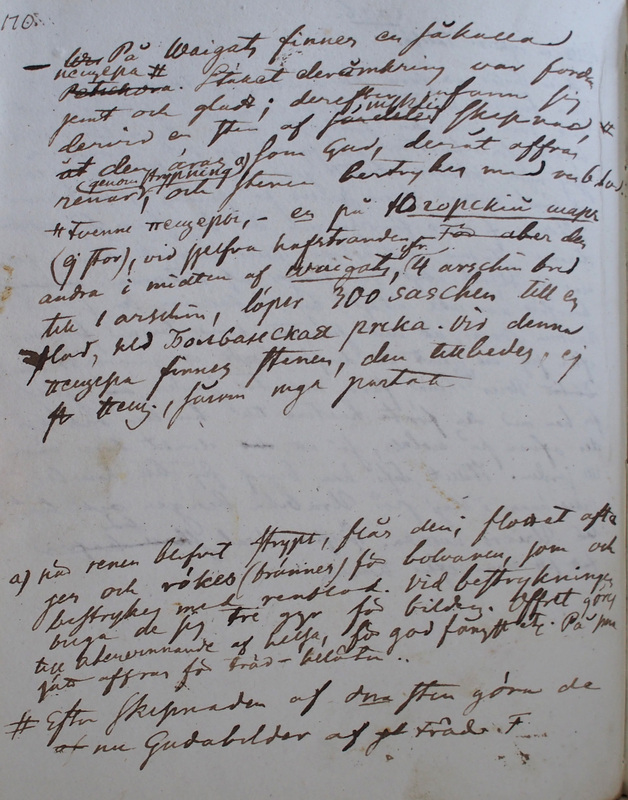Ethnographiska, historiska och statistiska anmärkningar. 170
Title
Ethnographiska, historiska och statistiska anmärkningar. 170
Description
|
På
Waigats
finnes en såkalladVajgač Island (TN Хэхэʹ я, Хэбидя я) in the Pečora Sea at N70°1′13″ E59°28′56″. (TS, KL)
Petschora пещера
tvenne пещеры, - en på Югорскiй шаръBolvanskij Nos (TN Хэхэʹ саля) is a high cliff face with an open cave situated at the southern end of the island. The sacrificial place situated on the hill is also called TN Вэсако ‘Old man’, and it is further described on page 180. [180: Hähe salje] (Schrenk 1848: 353–354; Islavin 1847; 114–118; Bojarskij 2000: 80)
(ej stor), vid sjelfva hafstranden. Den andra i mitten af Waigats, ifrån 4 arschin bred; till 1 arschin, löper 300 saschen till en
«Efter skepnaden af dna[denna] sten göra de flod, kld[kallad] Болванская река.
Vid dennaThe Bolvanskaja reka (TN Хэхэ' яха). A river flowing in the canyon between Bolʹšaja bolvanskaja gora and Malaja bolvanskaja gora. Castrén is here referring to what was later called the sacrificial place of the Bolʹšaja Bolvanskaja hill, situated in the highest place of the island. The place is also known as TN Хадако or Небяʹ хэхэ. According to Bojarskij, there is a long and deep cleft in the northern side of the place, “resembling a womb”.
пещера finnes stenen, den tillbedes, ej пещ[ера]. såsom mga[många] qvartar. Stället der omkring var fordom jemt och glatt; derefter infann sig dervid en sten af särdeles msklig[mänsklig] skepnad, nu Gudabilder af träd.» åt den äras som Gud, deråt offras renar genom strypning «När renen blifvt strypt, slås den i flottet ges och rökes (brännes) för bolvanen, som ock bestrykes med renblod. Vid bestrykningen buga de sig tre ggn[gånger] för bilden. Offret göres till återvinnande af helsa, för god fångst etc. På sna[sådana] sätt offras för träd-beläten.» och stenen bestrykes med renblod. |
There are two so-called peščery in Waigats, one in Jugorskij šarʹʹ (not large), by the very seashore. The other in the middle of Waigats, from four to one arschin wide, runs 300 saschen to a river, called Bolvanskaja reka. At this peščera, there is a stone, which is worshipped, not a peščera, as in many other caves. The place around the place used to be even and smooth; then a stone with a human form appeared. «Nowadays, they make images of gods of trees following the shape of this stone.»
it [the stone] is worshipped as a God; they sacrifice strangled reindeer to it. «When the reindeer has been strangled, it is beaten; the fat is given and smoked (burned) for bolvanen, which are also spread with reindeer blood. When spreading the blood, they genuflect three times to the image. The sacrifice is made for the recovery of health, for a good catch, etc. They sacrifice in a similar way for tree idols.»and the stone is spread with reindeer blood. |

